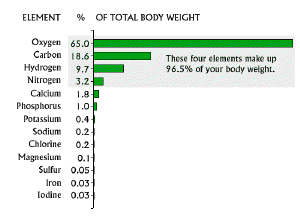Post
The Four Elements
18 April 2013
Around 450 BC, the Greek philosopher Empedocles wrote that the world was comprised of four things: earth, air, fire and water. Plato referred to them as the four elements. These were not elements in the modern sense, but rather essences that gave everything their physical properties. The idea that everything was made of these fundamental elements had a deep influence on early Western science. It was a central aspect of alchemy until Robert Boyle demonstrated there were more than four elements in 1661. The four elements also connected to the four humours of the human body, which formed a basis of Western medicine until the 1800s.
 ASU School of Life Sciences
ASU School of Life SciencesOver the past two centuries, we have gained a much better understanding of the atomic elements and how they have formed. One of the things we have learned is that we—and every other living thing on Earth—are made up mostly of four elements. These four atomic elements are oxygen, carbon, hydrogen, and nitrogen. Together they make up about 96% of our bodies, as you can see in the figure above. There are 92 naturally occurring elements on Earth, from hydrogen to uranium, so why do these four make up such a majority of living things? Part of the reason lies in the fact that they are versatile elements, capable of producing a vast array of chemical compounds, but it also has to do with the fact that they are among the most abundant elements in the universe. To understand why, we have to look to the stars.
The first elements appeared a few minutes after the big bang, through a process known as nucleosynthesis. The elements produced by the big bang consisted of about 75% hydrogen and 25% helium (by mass) with trace amounts of lithium and beryllium. For the next several hundred million years only these four elements existed. Then the first stars appeared. They formed from large clouds of hydrogen and helium, and as they collapsed under their own weight the hydrogen in their cores began to fuse into helium.
The energy produced by this nuclear fusion gives a star the light and heat necessary to counter the force of gravity for a time, but as a star ages the amount of helium in the stellar core increased. As helium become more plentiful in the stars core, some of it fuses into carbon. The carbon interacts with the hydrogen to produce nitrogen and oxygen as well as helium, through a process known as the CNO cycle. As a star ages the CNO cycle becomes the dominant process by which a star creates light and heat. As a result, these elements become fairly plentiful within a star.
The first stars are thought to have been very large stars. Toward the end of a their lives they produced even heavier elements, such as silicon, neon, and eventually iron. Beyond iron there are no elements a star can fuse to produce energy. After several hundred thousand years these first stars had no further way to produce energy, and in the end they explode in a massive explosion known as a supernova. The gas and dust remnants of these stars were tossed out into the universe. Over time this gas and dust became part of clouds that formed new stars, which also fused hydrogen and helium into heavier elements until they too died in supernova explosions.
Then about five billion years ago a cloud of gas and dust began to form a new star. Thanks to the lives and deaths of earlier generations of stars this cloud was rich not just in hydrogen and helium, but also in carbon, nitrogen, oxygen, and iron. As the star formed, some of the dust formed a disk around the star, out of which formed planets. The third planet from this star had the good fortune of being not too close to the star and not too far away. It had plenty of hydrogen and oxygen in the form of water, as well as carbon and nitrogen, all thanks to long dead stars. Eventually life appeared on this small world, and took advantage of these useful and plentiful elements.
The atoms in your body contain the history of the universe. The hydrogen in your body was born among the first elements, about 13.7 billion years ago. The carbon, nitrogen and oxygen in your muscles and mind were created within a star that died more than 5 billion years ago.
You are the universe made manifest.